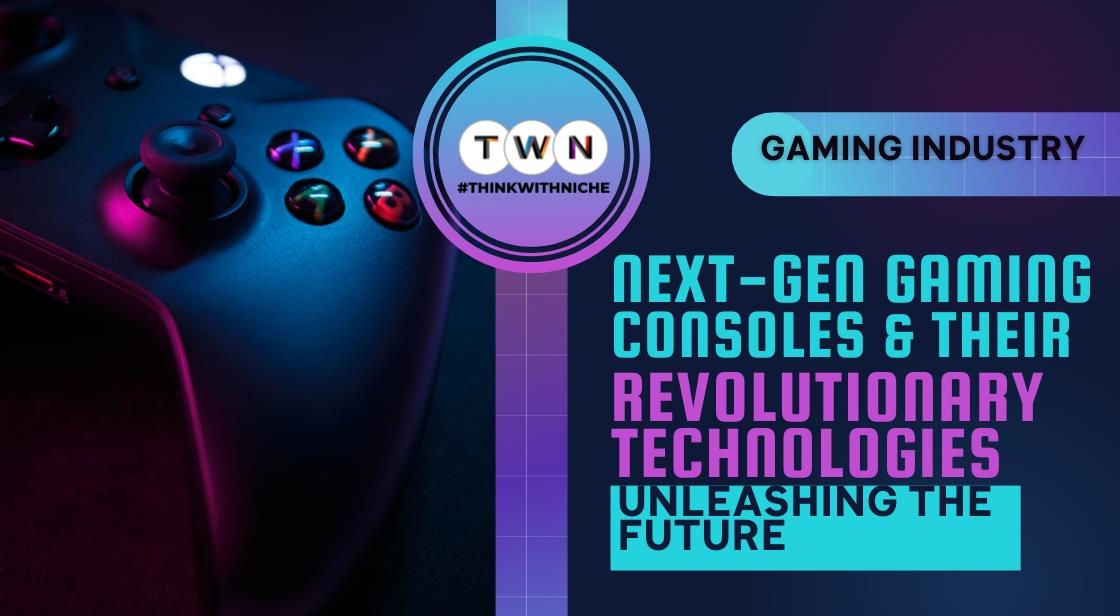Next-Gen Gaming Consoles and Their Revolutionary Technologies: Unleashing the Future

Blog Post
The dawn of next-generation gaming consoles heralds a new era of gaming, characterized by revolutionary technologies that promise to redefine the gaming landscape. As gaming enthusiasts eagerly await the arrival of these cutting-edge consoles, anticipation mounts for the transformative experiences they will deliver.
From the powerhouse capabilities of advanced CPUs and GPUs to the lightning-fast SSD storage and immersive ray tracing technology, next-gen consoles represent a quantum leap in gaming hardware. The convergence of these revolutionary technologies not only enhances the performance of games but also opens up new realms of possibility for game developers and players alike.
With the promise of enhanced graphical fidelity, higher frame rates, and reduced loading times, next-gen consoles are poised to elevate gaming experiences to unprecedented levels of immersion and realism.
Moreover, the innovative features integrated into these consoles, such as advanced controller designs and immersive haptic feedback, further blur the line between virtual and reality.
Beyond mere hardware advancements, next-gen consoles are set to unleash a wave of innovation that extends to the entire gaming ecosystem. From cloud gaming services to seamless integration with virtual reality platforms, these consoles are redefining the way players engage with games and interact with each other.
As the gaming industry continues to evolve, next-gen consoles stand at the forefront of this evolution, driving forward the boundaries of what is possible in gaming.
With each new announcement and demonstration, excitement builds, fueling anticipation for the future of gaming and the unparalleled experiences it holds in store. In this era of unprecedented technological advancement, next-gen gaming consoles are not just devices; they are gateways to a future where the possibilities of gaming are limitless.
The Evolution Continues: Next-Gen Consoles and Their Impact
Introduction to Next-Gen Gaming Consoles:
Definition of Next-generation gaming consoles
Next-generation gaming consoles refer to the latest iteration of gaming hardware that represents a significant leap forward in terms of technology and capabilities. These consoles typically offer enhanced graphics, processing power, and features compared to their predecessors.
Significance in the Gaming Industry:
-
Next-gen consoles play a crucial role in driving innovation and progress within the gaming industry.
-
They set new standards for graphics, performance, and gameplay experiences, pushing developers to create more immersive and engaging content.
-
Their release generates significant buzz and anticipation among gamers worldwide, leading to increased sales and revenue for both console manufacturers and game developers.
Major Players in the Market:
-
Sony: Known for its PlayStation brand, Sony has been a dominant force in the console market for decades. The PlayStation consoles have a large and loyal fan base, and each new generation brings forth groundbreaking technologies and exclusive gaming experiences.
-
Microsoft: With its Xbox series, Microsoft is a major competitor in the gaming console market. The Xbox consoles offer powerful hardware, robust online services, and a diverse lineup of games, making them a popular choice among gamers.
-
Nintendo: While not always directly competing in terms of raw power, Nintendo's consoles, such as the Switch, offer unique features like portability and innovative gameplay experiences. They cater to a different demographic and have carved out a niche in the market.
-
Emerging Competitors: Besides the established players, there are emerging competitors entering the market, aiming to disrupt the status quo with their own innovative approaches to gaming hardware. These newcomers may introduce fresh ideas and competition, further driving innovation in the industry.
next-gen gaming consoles represent the forefront of gaming technology, with major players like Sony, Microsoft, and Nintendo leading the charge and shaping the future of interactive entertainment.
Revolutionary Technologies:
Next-gen consoles integrate a range of revolutionary technologies, including advanced CPUs and GPUs, high-speed SSD storage, ray tracing for realistic graphics, hardware-accelerated ray tracing, and machine learning/AI capabilities.
These technologies collectively push the boundaries of gaming and enable developers to create immersive, lifelike experiences that were previously unimaginable.
Advanced CPUs and GPUs:
-
Next-gen consoles boast highly advanced central processing units (CPUs) and graphics processing units (GPUs) compared to their predecessors.
-
These CPUs and GPUs feature increased processing power, allowing for more complex calculations and rendering of lifelike graphics.
-
Enhanced CPU and GPU capabilities enable developers to create games with larger worlds, more detailed environments, and more sophisticated artificial intelligence.
High-Speed SSD Storage:
-
One of the most significant advancements in next-gen consoles is the adoption of high-speed solid-state drive (SSD) storage.
-
SSDs offer significantly faster data transfer rates compared to traditional hard disk drives (HDDs), resulting in reduced loading times and faster game asset streaming.
-
With SSD storage, players can expect quicker game startup times, seamless transitions between game environments, and virtually no loading screens, enhancing the overall gaming experience.
Ray Tracing for Realistic Graphics:
-
Ray tracing is a rendering technique that simulates the behavior of light in a virtual environment, resulting in highly realistic and immersive graphics.
-
Next-gen consoles utilize hardware-accelerated ray tracing to achieve cinematic-quality visuals with accurate lighting, reflections, and shadows.
-
With ray tracing, games can achieve unparalleled levels of visual fidelity, bringing virtual worlds to life with stunning realism and depth.
Hardware-Accelerated Ray Tracing:
-
Hardware-accelerated ray tracing is a dedicated hardware feature integrated into next-gen consoles' GPUs.
-
This feature offloads the computational workload of ray tracing from the CPU or GPU, resulting in smoother performance and more efficient rendering.
-
Hardware-accelerated ray tracing enables developers to implement advanced lighting effects and realistic reflections without sacrificing overall game performance.
Machine Learning and AI:
-
Next-gen consoles may also incorporate machine learning and artificial intelligence (AI) technologies to enhance gaming experiences.
-
Machine learning algorithms can be used to improve various aspects of gameplay, such as NPC behavior, enemy AI, and player interactions.
-
AI-powered features can adapt to players' preferences and behaviors, providing personalized gaming experiences and dynamically adjusting game difficulty.
Unleashing the Future:
Introduction to Revolutionary Technologies:
-
The term "revolutionary technologies" refers to the cutting-edge advancements in hardware and software that are driving the next generation of gaming consoles.
-
These technologies include powerful CPUs and GPUs, high-speed solid-state drives (SSDs), ray tracing for realistic lighting and reflections, and advanced AI algorithms for more immersive gameplay.
Also Read: Top Money-Making Apps for Quick Earnings
Shaping the Future of Gaming:
-
Revolutionary technologies are fundamentally changing the way games are developed, played, and experienced.
-
Developers now have access to unprecedented levels of computing power and graphical fidelity, enabling them to create more detailed worlds, complex simulations, and innovative gameplay mechanics.
Impact on Game Development:
Game developers are leveraging these technologies to push the boundaries of what's possible in gaming. They can create larger, more dynamic environments with realistic physics, lifelike character animations, and immersive audio.
Additionally, tools like machine learning and procedural generation are revolutionizing game design by automating tasks and generating content dynamically.
Enhanced Player Experiences:
-
Players are benefiting from these advancements through more immersive and engaging gaming experiences.
-
Enhanced graphics and physics create more lifelike worlds that draw players deeper into the game's narrative and atmosphere.
-
Faster load times and seamless transitions between gameplay and cutscenes improve immersion and reduce frustration.
Evolution of Player Interaction:
-
Revolutionary technologies are also changing how players interact with games.
-
Advanced haptic feedback in controllers provides tactile sensations that enhance immersion and realism.
-
VR and AR technologies offer new ways to experience games, allowing players to step into virtual worlds and interact with characters and environments in unprecedented ways.
Overall Impact on Gaming Ecosystem:
The introduction of next-gen consoles and their revolutionary technologies is reshaping the entire gaming ecosystem. Developers are exploring new genres, gameplay mechanics, and storytelling techniques made possible by these advancements.
Streaming services and cloud gaming platforms are expanding access to games and reaching new audiences, further democratizing the gaming experience.
Enhanced Performance:
Graphics Advancements:
-
Next-gen consoles employ advanced GPUs (Graphics Processing Units) capable of rendering highly detailed environments, characters, and effects.
-
These GPUs support features like ray tracing, which accurately simulates the behavior of light, resulting in more realistic lighting, reflections, and shadows.
-
Higher resolutions, such as 4K and even 8K, are supported, delivering sharper and more detailed visuals than previous console generations.
Processing Speed:
-
Next-gen consoles are equipped with powerful CPUs (Central Processing Units) that handle complex calculations and AI (Artificial Intelligence) tasks more efficiently.
-
Faster processing speeds contribute to smoother gameplay experiences, allowing for more dynamic environments, larger crowds, and more responsive AI behavior.
Frame Rate:
-
One of the most noticeable improvements in next-gen consoles is the potential for higher frame rates.
-
A higher frame rate results in smoother motion and more fluid animations, enhancing the overall gaming experience.
-
While previous consoles typically targeted 30 frames per second (fps), next-gen consoles aim for 60 fps or even higher in some cases, providing a more immersive and responsive feel to games.
Reduced Loading Times:
-
Next-gen consoles leverage high-speed SSD (Solid State Drive) storage technology to significantly reduce loading times.
-
Games load faster, allowing players to jump into the action more quickly without long wait times for levels or scenes to load.
-
This not only improves convenience but also enhances immersion by maintaining momentum and flow within the gaming experience.
Improved Game Physics:
-
Next-gen consoles enhance game physics simulations, allowing for more realistic interactions between objects, characters, and environments.
-
Physics-based effects like destructible environments, realistic cloth and fluid dynamics, and lifelike animations are more pronounced and immersive.
-
This adds depth and realism to gameplay, making interactions feel more natural and dynamic.
Overall Gameplay Fluidity:
-
Collectively, these advancements in graphics, processing speed, frame rate, loading times, and game physics contribute to a smoother and more fluid gameplay experience.
-
Players enjoy games that feel more responsive, immersive, and engaging, blurring the lines between virtual worlds and reality.
next-gen gaming consoles deliver enhanced performance across various aspects, including graphics, processing speed, frame rate, loading times, and game physics, resulting in a more immersive and enjoyable gaming experience for players.
Innovative Features:
Advanced Controller Designs:
-
Next-gen consoles are introducing controllers with innovative designs aimed at enhancing gameplay immersion and comfort.
-
Examples include adaptive triggers that provide varying levels of resistance depending on in-game actions, improved ergonomics for extended gaming sessions, and customizable button layouts for personalized gaming experiences.
-
These controllers may also feature built-in sensors for more precise motion tracking and interaction with in-game environments.
Enhanced Haptic Feedback:
-
Next-gen consoles are leveraging advanced haptic feedback technology to provide players with more tactile and immersive gaming experiences.
-
Haptic feedback allows players to feel subtle vibrations and sensations that correspond to in-game actions, such as the recoil of a weapon, the rumble of a vehicle engine, or the impact of a collision.
-
This technology enhances realism and immersion, making gameplay more engaging and immersive than ever before.
Improved User Interfaces:
-
Next-gen consoles are introducing redesigned user interfaces (UIs) that prioritize ease of use, customization, and accessibility.
-
These UIs feature sleek, modern designs with intuitive navigation menus, customizable themes, and dynamic backgrounds.
-
Enhanced social features, such as integrated voice chat, party systems, and seamless sharing of screenshots and video clips, make it easier for players to connect and interact with friends and fellow gamers.
Integration with Emerging Technologies:
-
Next-gen consoles are embracing emerging technologies like virtual reality (VR) and augmented reality (AR) to expand the possibilities of gaming.
-
VR integration allows players to immerse themselves in virtual worlds and experience games in a whole new way, with realistic 3D environments and immersive interactions.
-
AR integration enables mixed-reality experiences where digital elements are overlaid onto the real world, blurring the lines between virtual and physical gaming experiences.
-
These integrations open up new avenues for innovative gameplay mechanics, storytelling techniques, and social interactions, paving the way for entirely new genres of games and experiences.
Ecosystem and Future Prospects:
Next-Gen Consoles in the Gaming Ecosystem:
-
Next-gen consoles are not standalone devices but integral parts of a larger gaming ecosystem.
-
They interact with various components like game developers, online services, gaming communities, and hardware peripherals.
Also Read: 10 Easy Ways To Make Money Playing Video Games
Online Services:
-
Next-gen consoles offer robust online services, including digital game stores, multiplayer gaming, and subscription-based services like Xbox Game Pass or PlayStation Now.
-
These services enhance the gaming experience by providing access to a vast library of games, exclusive content, and multiplayer functionality.
Social Features:
-
Social features play a significant role in next-gen consoles, facilitating interaction among players.
-
Features like in-game chat, party systems, and social media integration enable players to connect, communicate, and share their gaming experiences with friends and communities.
Cross-Platform Compatibility:
-
Next-gen consoles are increasingly embracing cross-platform compatibility, allowing players to enjoy games across different devices.
-
This trend promotes inclusivity and expands the player base by breaking down barriers between consoles, PC, and mobile platforms.
Future Evolution Through Software Updates:
-
Next-gen consoles will continue to evolve through regular software updates, delivering new features, performance improvements, and security enhancements.
-
These updates ensure that consoles remain up-to-date with the latest technological advancements and address user feedback and emerging trends.
New Peripherals:
-
As technology advances, new peripherals and accessories will be developed to complement next-gen consoles.
-
Examples include VR headsets, advanced controllers with haptic feedback, and augmented reality devices, enhancing immersion and gameplay experiences.
Community-Driven Innovations:
-
Gaming communities play a vital role in shaping the future of next-gen consoles.
-
Community feedback and grassroots innovations drive the development of new features, mods, and user-generated content, enriching the gaming experience and fostering creativity.
Emerging Technologies:
-
Next-gen consoles will likely incorporate emerging technologies like cloud gaming, AI-driven experiences, and immersive simulations.
-
These technologies have the potential to revolutionize gaming by expanding accessibility, enabling new forms of gameplay, and blurring the lines between virtual and real-world experiences.
Conclusion:
The conclusion of the topic emphasizes the significant role that next-gen gaming consoles play in shaping the future of gaming. It highlights their potential to revolutionize gaming experiences through advanced technologies and innovative features. Encouraging readers to stay updated on further developments suggests the ongoing excitement and evolution within the gaming industry, inviting them to immerse themselves in the thrilling experiences these consoles offer firsthand.
You May Like
EDITOR’S CHOICE












